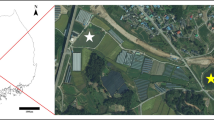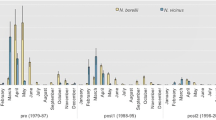Abstract
The bullfrog, Lithobates catesbeianus, is one of the most important invasive anurans, affecting especially native anurans due to their similar habits. Here we used a hierarchical co-occurrence model fit in a Bayesian framework to investigate the effects of the bullfrog on two native frog species from southern Brazil, testing the hypothesis that bullfrog presence changes the activity of native species and their relationship with habitat. We found that both occupancy and detection probabilities of native species were similar with bullfrog presence or absence at a site. However, we observed changes in activity and microhabitat use preferences of both native species when the bullfrog was present, suggesting that the presence of the invasive species altered the behavior of the native species. Changes induced by invasive species can result in severe long-term consequences for native species since niche differentiation may not mediate the ability of species to persist together indefinitely.
Graphic abstract



Similar content being viewed by others
Change history
05 February 2021
A Correction to this paper has been published: https://doi.org/10.1007/s10530-020-02416-0
References
Blaustein AR, Kiesecker JM (2002) Complexity in conservation: lessons from the global decline of amphibian populations. Ecol Lett 5:597–608. https://doi.org/10.1046/j.1461-0248.2002.00352.x
Borchers D, Zucchini W, Fewster R (1998) Mark-recapture models for line transect surveys. Biometrics 54:1207–1220
Both C, Grant T (2012) Biological invasions and the acoustic niche: the effect of bullfrog calls on the acoustic signals of white-banded tree frogs. Biol Lett 8:714–716. https://doi.org/10.1098/rsbl.2012.0412
Both C, Lingnau R, dos Santos-Jr AP et al (2011) Widespread Occurrence of the American Bullfrog, Lithobates catesbeianus (Shaw, 1802) (Anura: Ranidae), in Brazil. South Am J Herpetol 6:127–134. https://doi.org/10.2994/057.006.0203
Brooks SP, Gelman A (1998) General methods for monitoring convergence of iterative simulations. J Comput Graph Stat 7:434–455. https://doi.org/10.1080/10618600.1998.10474787
Gobel N, Laufer G, Cortizas S (2019) Changes in aquatic communities recently invaded by a top predator: evidence of American bullfrogs in Aceguá, Uruguay. Aquat Sci 81:1–11. https://doi.org/10.1007/s00027-018-0604-1
Greenlees MJ, Brown GP, Webb JK et al (2007) Do invasive cane toads (Chaunus marinus) compete with Australian frogs (Cyclorana australis)? Austral Ecol 32:900–907. https://doi.org/10.1111/j.1442-9993.2007.01778.x
Hoare JM, Pledger S, Nelson NJ, Daugherty CH (2007) Avoiding aliens: behavioural plasticity in habitat use enables large, nocturnal geckos to survive Pacific rat invasions. Biol Conserv 6:510–519. https://doi.org/10.1016/j.biocon.2006.12.022
Kats LB, Ferrer RP (2003) Alien predators and amphibian declines: review of two decades of science and the transition to conservation. Divers Distrib 9:99–110. https://doi.org/10.1046/j.1472-4642.2003.00013.x
Kellner K (2014) jagsUI: Run JAGS (specifically, libjags) from R: an alternative user interface for rjags. R package version 1.1
Kéry M, Royle J (2016) Applied hierarchical modeling in ecology: analysis of distribution, abundance and species richness using R and BUGS. Academic Press, San Diego
Kiesecker JM, Blaustein AR (1997) Population differences in responses of red-legged frogs (Rana aurora) to introduced bullfrogs. Ecology 78:1752–1760
Langone JA (1994) Ranas y sapos del Uruguay (Reconocimientos y aspectos biológicos). Mus Damaso Antonio Larrañaga, Ser Divulg 5:1–123
Leibold MA, Mcpeek MA, Mcpeek A (2009) Coexistence of the niche and neutral perspectives in community. Ecol Soc Am Stable 87:1399–1410
Mayer M, Brown GP, Zimmermann B et al (2015) Habitat use of the introduced cane toad (Rhinella marina) and native frog species in tropical Australia. J Trop Ecol 31:531–540. https://doi.org/10.1017/S0266467415000474
Nunes AL, Fill JM, Davies SJ et al (2019) A global meta-analysis of the ecological impacts of alien species on native amphibians. Proc R Soc B Biol Sci 286:20182528. https://doi.org/10.1098/rspb.2018.2528
Plummer M (2003) JAGS: a program for analysis of bayesian graphical models using Gibbs sampling. In: Hornik K, Leisch F, Zeileis A (eds) Proceedings of the 3rd international workshop on distributed statistical computing. https://www.r-project.org/conferences/DSC-2003/
R Core Team (2019) R: a language and environment for statistical computing. R Foundation for Statistical Computing, Vienna. https://www.R-project.org
Schumacher BD, Parrish JD (2005) Spatial relationships between an introduced snapper and native goatfishes on Hawaiian reefs. Biol Invasions 7:925–933. https://doi.org/10.1007/s10530-004-2983-6
Sebastián OS, Navarro J, Llorente GA, Richter-boix Á (2015) Trophic strategies of a non-native and a native amphibian species in shared ponds. PLoS ONE 10:e0130549
Simberloff D, Martin JL, Genovesi P et al (2013) Impacts of biological invasions: what’s what and the way forward. Trends Ecol Evol 28:58–66. https://doi.org/10.1016/j.tree.2012.07.013
Strebel N, Kéry M, Schaub M, Schmid H (2014) Studying phenology by flexible modelling of seasonal detectability peaks. Methods Ecol Evol 5:483–490. https://doi.org/10.1111/2041-210X.12175
Waddle JH, Dorazio RM, Walls SC et al (2010) A new parameterization for estimating co-occurrence of interacting species. Ecol Appl 20:1467–1475. https://doi.org/10.1890/09-0850.1
Zank C, Di-Bernardo M, Lingnau R et al (2008) Calling activity and agonistic behavior of Pseudis minuta Günther, 1858 (Anura, Hylidae, Hylinae) in the Reserva Biológica do Lami, Porto Alegre, Brazil. South Am J Herpetol 3:51–57. https://doi.org/10.2994/1808-9798(2008)3%5b51:caaabo%5d2.0.co;2
Acknowledgements
We thank Larissa Bailey, Marc Kéry, John Measey, Camila Both, Caroline Zank, Maria João Pereira and three anonymous reviewers for their comments and Victoria Graves for the English review. We are grateful to our field crew for helping in data collection, and to the landowners that kindly allowed us access to their land. We also thank PPGBAN, Laura Verrastro and Fundação de Apoio da Universidade Federal do Rio Grande do Sul for financial support. SS and MG were both supported by Coordenação de Aperfeiçoamento de Pessoal de Nível Superior (CAPES) with a master and a postdoc (PNPD) scholarship, respectively. This study was conducted during a time of great political and economic difficulty in Brazil. Beyond their substantial cuts to research budgets, we also feel great dissatisfaction with the manner in which the Brazilian government has been attacking environmental agencies, researchers and universities. It is unacceptable to politicize rather than prioritize scientific investigation.
Author information
Authors and Affiliations
Contributions
Stephanie da Silva Silveira and Murilo Guimarães conceived the ideas and designed the experiment, Stephanie da Silva Silveira collected the data, Stephanie da Silva Silveira and Murilo Guimarães analyzed the data and contributed critically to the drafts and gave final approval for publication.
Corresponding author
Additional information
Publisher's Note
Springer Nature remains neutral with regard to jurisdictional claims in published maps and institutional affiliations.
The original version of this article was revised due to the wrong citation name of the first author.
Electronic supplementary material
Below is the link to the electronic supplementary material.
Rights and permissions
About this article
Cite this article
Silveira, S.S., Guimarães, M. The enemy within: consequences of the invasive bullfrog on native anuran populations. Biol Invasions 23, 373–378 (2021). https://doi.org/10.1007/s10530-020-02385-4
Received:
Accepted:
Published:
Issue Date:
DOI: https://doi.org/10.1007/s10530-020-02385-4




